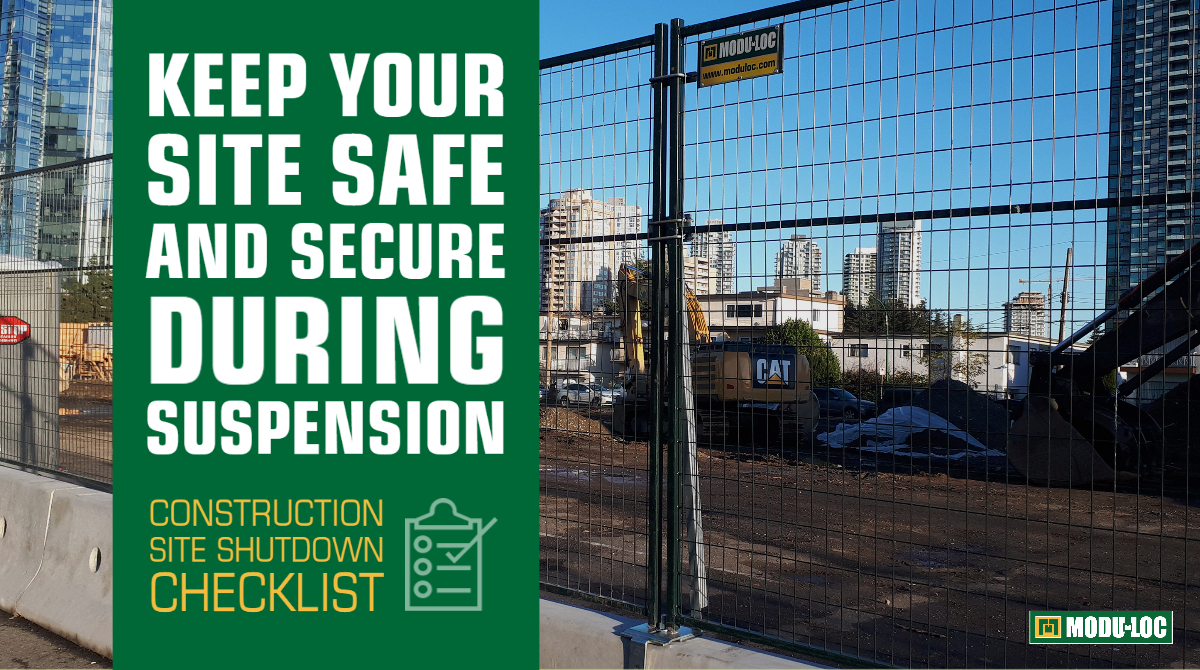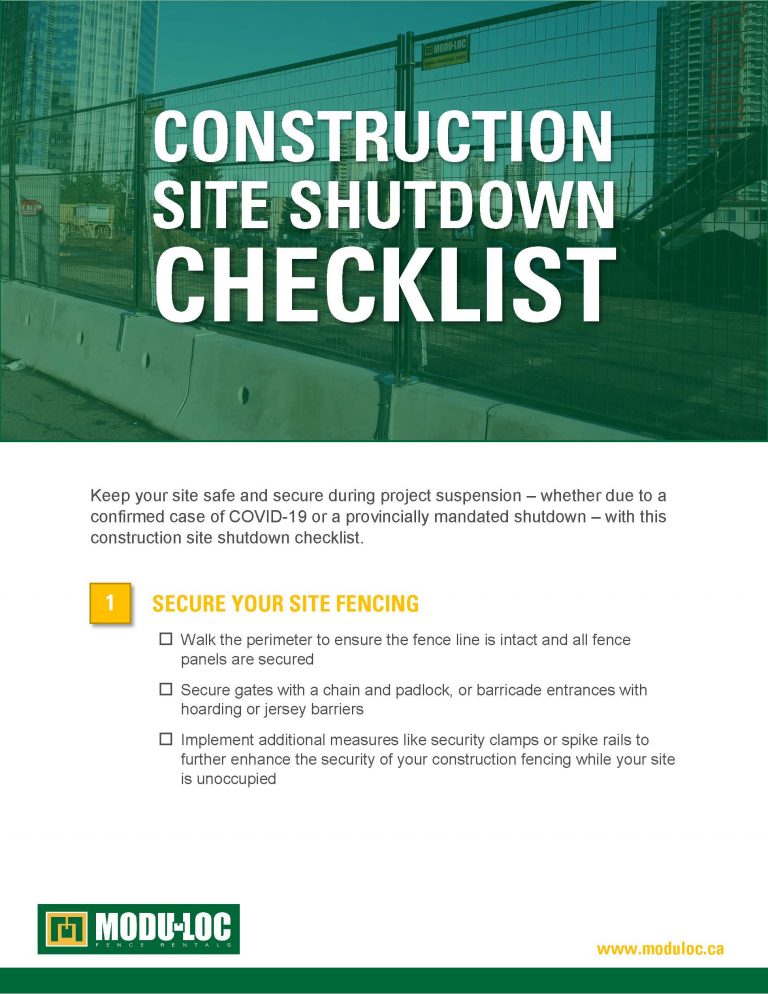Construction Site Shutdown Checklist
April 14, 2020Keep your site safe and secure during project suspension with this construction site shutdown checklist.

There is no denying that we have all had to adjust the way we do our work during this crisis. From the way we conduct orientations to the extra measures we’re taking to ensure hygiene on the job, the construction sites of today bear little resemblance to those we were familiar with pre-pandemic.
So the question is not whether the COVID-19 pandemic has had an impact on your construction project. The question is: to what extent?
In British Columbia and Alberta, construction projects have largely been allowed to continue. Provinces like Ontario and Quebec mandated the shut-down of non-essential businesses weeks ago, but initially listed construction as an essential service. More recently, the list of essential businesses has grown shorter. Now, only the most critical construction activity – like jobs related to hospitals or infrastructure – is being allowed to progress.
The progression of this situation has been all but impossible to predict. New information regarding the novel coronavirus emerges every week, and so our best course of action is to try and prepare for worst-case scenarios.
In the construction industry, this means being prepared to suspend project activity at a moment’s notice. It is crucial to have a rapid demobilization plan in place in case your project is suspended – whether that’s due to a confirmed COVID-19 case on your site, or a provincially mandated shut-down. This plan should account for properly locking down your site so that it remains safe and secure during suspension.
Here is a checklist of things you should consider when working through site security as part of a demobilization plan. A printable version of this checklist is available at the end of this post.
Secure Your Site Fencing
More often than not, theft is a crime of opportunity. In the construction industry, this means that sites which are remote, poorly lit, or insufficiently secured are the most attractive targets. Temporary construction fence is your last line of defence, and it’s more than likely you already have your perimeter fenced. What you need to do in the case of a site shutdown is ensure your fence is properly secured.
- Fence panels are sometimes removed so that trades, subcontractors, and employees can easily gain access to the site – particularly when moving large equipment. Before shutting down the site, walk the perimeter to ensure the fence line is intact.
- According to our friends at Radius Security, the largest-value thefts often happen near non-secured gates. Either secure gates with a chain and padlock, or barricade entrances with hoarding or jersey barriers.
- Consider implementing additional measures to further enhance the security of your construction fencing while your site is unoccupied. Security clamps and spike rails are visual and physical breach deterrents to would-be thieves.
Protect Your Valuables
Your “Plan A” should be to remove valuables from the site, and remind your subcontractors to do the same. However, this isn’t always possible or practical. If valuable tools, equipment, and material need to remain on site, protect them by doing the following:
- Move them away from the fence line, and preferably out of sight. According to Mike Baxter, Director of Sales for Radius Security, “It’s smart to deter potential trespassers by not leaving anything of value out in the open or near fence lines; even an electrical cord will look appealing for someone looking for copper!” If thieves can’t see anything worth stealing, they’re less likely to take the risk of breaking into a site.
- If possible, store equipment and tools in a locked shed or trailer.
- “Consider blocking visibility in key areas using hoarding or marketing banners on your fencing is a great option – just make sure they’re tied down,” says Mr. Baxter. If possible, add hoarding or privacy screen to your site perimeter to further block sightlines and hide your valuables.
- Wherever possible, immobilize your equipment so that it can’t be removed from the site – even if a thief gains access. Remove batteries or even wheels to make equipment impossible to move, and make use of cab locks and devices designed to lock out controls.
Make it Look Imposing
Visual breach deterrents can go a long way to sending thieves looking for an easier target. From low-cost solutions like signage to high-tech surveillance systems, here are some ways to make your site look more imposing:
- If you don’t already have it, consider adding some signs to your perimeter as part of your demobilization plan. Signage need not be beautifully designed. It just needs to communicate a few key messages, like “NO TRESPASSING”. If you have some sort of surveillance system, make it known through the use of strategically placed signage.
- Shed light on your perimeter. Though it seems pointless to light an unoccupied worksite, keeping lights on your hoarding or perimeter fencing will make it much more difficult for would-be thieves to go undetected, and may deter opportunistic criminals.
- Consider adding cameras. Though studies have yielded conflicting results about the efficacy of cameras in deterring crime, some research supports the use of cameras as a deterrent to theft. If you can afford it, get the remote guard service to go along with your surveillance system. This will ensure your site remains monitored even while it is unoccupied.If you do decide to implement remote monitoring, get your request in as early as possible. Remote guarding and surveillance companies are likely to have their hands full right now. As Mr. Baxter shared, “Make sure you check in with your security provider to arm your site for 24/h. Many of our customers have already moved to 24/7 monitoring, so it’s best to give as much notice as possible.”
Don’t Forget to Make it Safe
While it’s common to find a number of potential hazards on an active construction site, an unoccupied site can still pose a threat to safety. From thrill seekers looking to scale a crane (and potentially spurred by the boredom of social distancing!) to weather-related challenges, a demobilization plan should take into account potential risks to the public.
- Walk the perimeter of your site to ensure that there are no potential trip hazards caused by the bases or “feet” of your temporary fence. If you are concerned about a trip-and-fall risk, consider moving the fence line or installing safety ramps to mitigate the hazard.
- Secure anything that could be susceptible to the wind. That includes temporary structures and even your perimeter fencing. Making a small investment in properly securing or anchoring these structures could save you from a costly lawsuit.
- Set up an additional compound around the base of your crane using hoarding or a high-security fence system. Use security clamps or chains and padlocks to prevent unauthorized access to the crane.
A project suspension requires the coordination of a lot of moving parts – often in a very short time frame. Having a detailed and documented rapid demobilization plan will ensure you are ready to safely and securely lock down your site if the need arises. The tips outlined here will help ensure the security of a suspended work site, and protect you from theft and liability until work can resume as normal.
We’re here to answer any questions you may have.



 Canada - EN
Canada - EN Canada - FR
Canada - FR United States
United States





